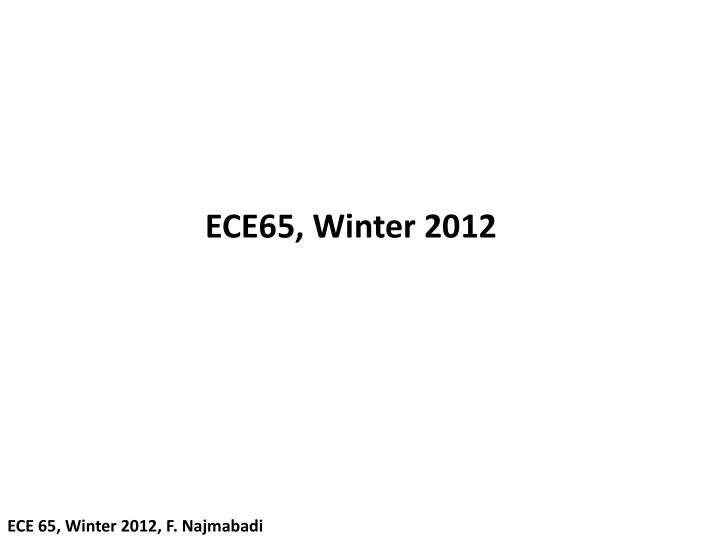



ECE65, Winter 2012 ECE 65, Winter 2012, F. Najmabadi
Instructor Farrokh Najmabadi fnajmabadi@fusion.ucsd.edu Office: 457 EBUII Office Hours: Monday 11:15-12:30, Thursday: 10-11:30 o Or by appointment (send E-mail) o Or drop-in (no guaranty!) o Lab: 329 EBUII PSpice Lab: 339 EBUII (Open 24/7, Code: 0602105) F. Najmabadi, ECE65, Winter 2012
Class Web Site http://aries.ucsd.edu/NAJMABADI/CLASS/ECE65/12-W Or go to o http://www.ece.ucsd.edu/classweb Look for ECE65 row and click on my name (middle column) Check the Web site regularly: o Class announcements, Lecture notes, slides, labs, will be posted on the Web site. F. Najmabadi, ECE65, Winter 2012
Text Books Most students find lecture notes sufficient (and it is free ) Recommended Text books: "Microelectronic Circuits," by Sedra and Smith (6th edition) o This is the textbook for ECE102 (and has material useful for ECE100). “Art of Electronics," by Horowitz & Hayes and its companion "Student manual for the Art of Electronics" by Hayes & Horowitz o Focuses on practical considerations in designing circuits o A great part is the exercise problems at the end of each chapter including “good” and “bad” circuits. o Drawback: It lacks necessary mathematical analysis. Lot’s of books in the library, each with a different “style”. F. Najmabadi, ECE65, Winter 2012
Syllabus We will use non-linear circuit elements, diodes and transistors, to build “functional” circuits. o Introduction to diodes and transistors physics and iv characteristics o Using linear-circuit theory to model circuits with these elements o Analyzing (and learning to design) “functional” circuits with these elements (e.g., wave-form shaping circuits, power supplies, digital gates, amplifiers). We will extensively use linear-circuit theory in this course (from ECE35): o Circuit analysis techniques (KVL, KCL, Node-voltage method) o Thevenin Theorem and Thevenin Equivalent circuit. I expect you to know this material well! Pre-req Quiz this Friday (Jan. 10) Sample quiz posted on the Web site. o F. Najmabadi, ECE65, Winter 2012
A major course goal is to learn the difference between models and reality! In Engineering, we use physical laws to model real-world systems which are complex. Our models are only approximations of practical systems. What we use in this course: Analysis (analytical hand-calculations) o Includes relevant physical phenomena. Approximations are used to simplify analysis. Gives insight in circuit behavior. Essential for “first- pass” design. Computer Simulation (PSpice) o Can model more complex system and/or more accurate analysis only because computer can do numerical analysis. Experiments : Reality! F. Najmabadi, ECE65, Winter 2012
PSpice Software: Self-Study You can download a demo (free) version of OrCAD Pspice from: http://www.cadence.com/products/orcad/pages/downloads.aspx PSpice Lab has the “full” version. There is a “PSpice” Primer posted on the Web site that is useful in starting on PSpice. Labs are constructed such that it gradually introduces different feature of PSpice software. o Lab 1 is an introduction to PSpice (due Jan. 25 in the class). o Lab tutors will be in the PSpice lab during the second week of classes to help you start with PSpice. F. Najmabadi, ECE65, Winter 2012
Course Mechanics/Labs Lectures are synced with the lab work. Lab exercises are designed to enforce the material covered in the lecture. Each lab includes several experiments and usually a design problem. o For each Lab experiment, you need to perform circuit analysis (analytical) and PSpice simulations before coming to the lab (pre-lab). o You build your circuit in the lab and perform measurements. o You will write a lab report (submitted the following week). Lab work is done by a team of two students. o You need to go to the section that you are signed in. o Each student needs to bring a pre-lab. o Each team, however, will write a lab report. F. Najmabadi, ECE65, Winter 2012
Lab Reports For each experiments, your lab report should include: 1. The motivation, 2. Circuit analysis/PSpice simulations (which you have done before coming to the Lab), 3. Experimental procedure (only if you had to do something special to get your data), 4. Data (in tables and plots), 5. Comparison of data with circuit analysis and simulation, 6. Your Conclusions and speculations. Lab reports should be a maximum of 7 pages (excluding PSpice simulation results). Print PSpice simulation and attach them to the report at the proper place (print-out should include time-stamp). F. Najmabadi, ECE65, Winter 2012
Efficient Lab Work Some work before coming to the Lab would greatly reduces the time you spent in the lab and the time for writing the report. o You can have more than half of your lab report assembled before coming to the lab. (1. The motivation, 2. Circuit analysis/PSpice simulations). o Make a table to compare analysis/simulation/measurements before coming to the class (2/3 filled). o Fill the table in the lab. You can see if there are any differences! (comparison between data and analysis). o If you write down a few sentences on what you learned in the lab on the spot, you have the technical part of your report assembled before leaving the lab. F. Najmabadi, ECE65, Winter 2012
Misc items Grading: Lab Reports: 25% Quiz 1: 5% (~6 th week of classes) Quiz 2: 10% (~8 th week of classes) Quiz 3: 10% Final: 50% Lab “experimentation” starts on the third week of classes. There is a lab “orientation” during the second week of classes. o Takes about 45 minutes and introduces you to various instruments in the lab. o Going to orientation is optional! o Students in Monday section, please check web site (in a couple of days) for alternative section. F. Najmabadi, ECE65, Winter 2012
Recommend
More recommend